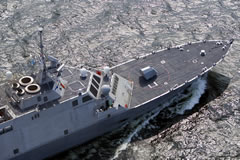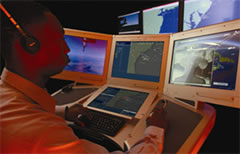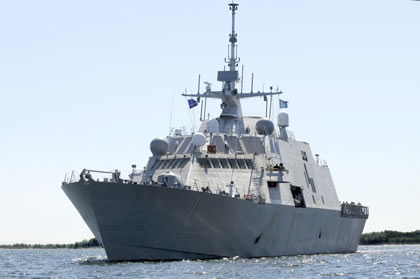As the first Littoral Combat Ship USS Freedom was delivered to the US Navy on September 18, 2008, marking the completion of the final sea trials phase, began on July 28, 2008 in Lake Michigan. While the US Navy suspended further acquisition of LCS class ships, Israel formally requested to buy up to four such light frigates built by Lockheed Martin. LCS can be configured to deploy with any one of three interchangeable mission modules: the anti-submarine warfare (ASW) module; mine countermeasures (MCM) module and surface warfare (SUW) module also know as mission packages.
The first vessel (LCS-1) was delivered with the ASW mission package (MP) utilizing several different vehicles the MH-60R helicopter, unmanned air vehicle, unmanned surface vehicle and associated sensors, including towed array sonar, remote towed active source, USV dipping sonar, multi-static off-board source — to detect, classify, localize, track and engage submarines in the littoral environment. According to U.S. Navy Program Executive Officer for Littoral and Mine Warfare, E. Anne Sandel, the LCS’ anti-submarine warfare mission package will provide the Navy with a persistent large area detection capability, through our advanced unmanned vehicles and bi-static ASW systems.
The Israeli variant (LCS-I) has been refined in the past two years, under close cooperation between the Israel Navy, the Ministry of Defense (MoD) and Lockheed Martin, in an effort to optimize the vessel for Israeli Navy requirements. According to the US Defense Security Cooperation Agency, the total cost of the program could reach $1.9 billion, provided that all four ships are procured. Israel’s MOD has set aside $200 million from its five year defense budget planning to fund the first ship, with additional $160 for its weapon systems suite. The second vessel will be funded under the next five-year budget, commencing 2013.
If the program is approved, Lockheed Martin will build the hull, mechanical and electrical systems, while the installation and integration of combat systems performed in both, US and Israel. Rafael Advanced defense Systems, Elbit Systems and Ness Technologies have already teamed with Lockheed Martin on the LCS-I program. As the program progresses, IAI is also expected to join, with Elta and MBT providing key systems including sensors, command, control and communications, as well as offensive and defensive systems.
Maximizing Multi-Mission Capability
The new vessel has a cruising speed of 40 knots, and a range of will benefit from speed and agility uncommon with current frigates, making it especially effective, to conduct operations in littoral waters. It is designed to be capable pf operating at low speeds, on littoral mission operations, transit at economical speeds, and conduct high-speed sprints, which may be necessary to avoid approaching threats, such as, for example, a small boat or submarine, conduct intercept operations over the horizon, or provide for naval commando insertion and extraction missions. The US Navy considers the LCS particularly effective in defeating asymmetric threats in the littorals, including mine warfare, engaging quiet diesel submarines and defeating fast surface craft. The vessel will also introduce dramatic improvements in support of manned and unmanned special operations, relying on its spacious integrated flight deck and capability to launch and recover manned or unmanned watercraft such naval comando fast boats or Rafael’s ‘Protector’ unmanned surface vessel.
Unlike the US ‘flexible design’ approach, the Israelis require their vessel to perform all the LCS missions in a single platform. As a multi-mission frigate LCS-I will be equipped as the baseline for anti-air, anti-submarine, anti-surface and anti-missile warfare missions, as well as special operations. This demanding approach required some compromises, including the elimination of the gun, which will be replaced by a Phalanx Close-In Weapon System. The ‘sacrifice’ of the medium caliber cannon has not been exceptional, since modern guided weapons are far more effective and cause less collateral damage, compared to a traditional cannon.
Considering the limited operational theater defined by Israel’s geo-strategic situation, Israel’s Navy has limited its requirement for large ‘corvette’ size vessels, rather than the larger frigates commonly operated in the ocean sea. The littoral combat ship design was found suitable for Israel’s specific operational concept. However, while the original LCS was designed to operate independently, or as part of a force-package, supported by much larger vessels, it’s mission in the Israeli Navy, is expected to become the centerpiece of Israel’s naval force, providing command, control, situational awareness and protection for a larger force, combining Saar 5/5B corvettes and Saar 4.5 missile boats.
Originally Israel considered have its LCS-I ‘piggy back’ on the construction of LCSs for the US Navy LCS, however, after construction for the first hull was exceeding $450 million. The US Navy cancelled the program. Israel and Saudi Arabia are currently the only potential buyers for this design. Israel requested competing proposals for similar designs, from four different shipyards, including Northrop Grumman, which has recently expanded its shipbuilding activity, the US Naval Architecture and Marine Engineering Company Alion.
Assessing Alternatives
Despite of the significant cost increase of the LCS platform, Lockheed Martin’s Freedom remains the only light frigate class vessel that could be procured, meeting the current Israeli schedule. All current naval vessel platforms under construction in the US are much larger. Some shipbuilders in Europe offer ‘light frigates’, but most of the active programs are focusing on larger vessels. Two European shipbuilders were approached by Israel – the German ThyssenKrupp Marine Systems (TKMS) which produces the F125 frigate for the German Navy and the Italian shipyard Fincantieri, which has produced four corvettes for the Italian Navy. None is suitable for the Israelis, which require a 2,000 – 3,000 ton platform. Israel could benefit from similar programs currently underway in other countries, such as the Republic of Korea, which has launched the construction of the ‘FFX’, a light and stealthy frigate, the first is planned to be completed by 2015.
TKMS, through its subsidiary HDW has already supplied three Dolphin submarines for the Israeli Navy and is on contract to deliver two additional subs. TKMS is currently producing four F125 a 6,800 ton Frigates for the German Navy. At present, TKMS does not have a US based subsidiary, which could benefit it from the U.S. Foreign Military Sale funding, allocated for Israel. A fifth proposal was submitted by the Italian shipbuilder Fincantieri, currently associated with two major programs – the joint Italian-French 5,900 ton FREMM class frigates, building with the French company DCN a new generation of frigates, and four Cigala Fulgosi class 1,500 ton corvettes, for the Italian Navy. While Fincantieri does have an American based subsidiary, it is not yet geared for major shipbuilding operations in the US.
LCS-I Weapons Complement
According to the US announcement, the LCS-I combat system will comprise of two MK-41 Vertical Launch Systems, each fitted with eight ready-to-fire missiles. These launchers could be equipped with Barak-8 medium-range air defense missiles, extending the ship’s protection beyond the range currently provided by the Barak-1 point defense systems, employed on Saar 5 corvettes and Saar 4.5 missile boats. Barak 8 is currently under development for the Indian and Israeli navies. Consequently, the Barak 8 will have to be integrated with the MK 41 Vertical Launch System (VLS), opening significant export potential for the new Israeli naval air-defense weapon systems.
The LCS-I will carry a single Phalanx Block 1A Close-In-Weapon System, replacing the Mk110 57mm stabilized gun. The Israeli vessel is likely to be installed with two Typhoon remotely controlled naval gun systems or its US Mk-38 Mod 2 derivative. As a self-contained, above-deck system, this configuration could provide the Israelis with enough space to more vertical launchers for Barak 8 or other missiles, extending its capability as an air-and missile-defense asset.
Four Enhanced HARPOON launchers will also be carried on deck, these could potentially carry either Harpoon or Gabriel V anti-ship missiles. As part of its anti-submarine warfare system, the LCS-I will also be equipped with two MK-32 Surface Vessel Torpedo Tubes (SVTT). This weapon complement is not significantly different from that carried on the current Saar 5 corvettes. Traditionally, the Israeli Navy packs significantly more weapons on deck, a trend that could be repeated with its new LCS.
Further adaptation could be made to the ship’s combat system. The vessel comes with the Lockheed Martin SPY-1F(V) and MK-99 Fire Control System as standard, parts of the AEGIS weapon system. The vessel will be controlled through the COMBATSS-21 which will also integrate with Israel’s Navy Command and Control (IC2) systems. The new EL/M-2248 MF-STAR phased array naval radar, locally built IAI/Elta Systems will be considered, as it is claimed to be superior and lighter than SPY-1F(V). Israel has an option to integrate this radar as well as its own combat system, datalinks and communications systems, sensors and defensive measures.






















